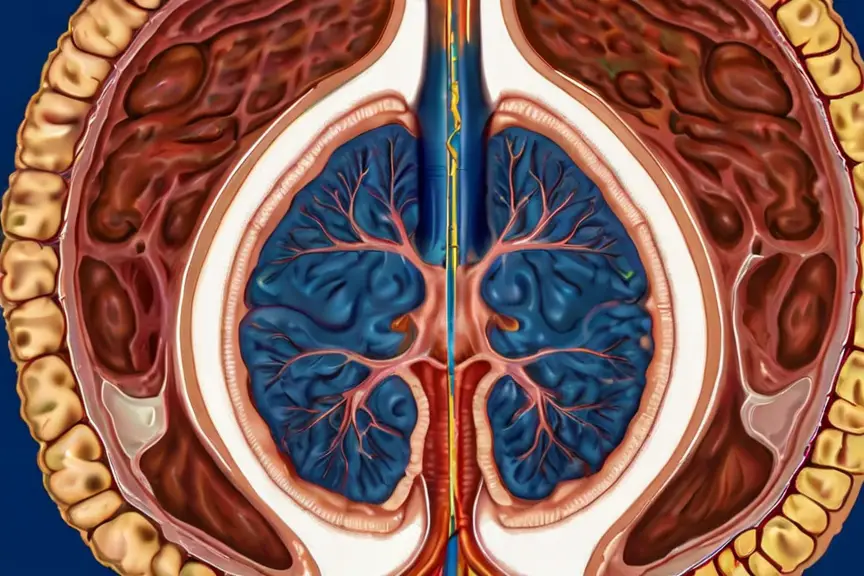
Malignant cerebral edema, also known as malignant brain edema, is a rare but life-threatening condition that affects the brain.
It is characterized by the rapid accumulation of fluid in the brain, leading to increased pressure within the skull.
In this blog post, we will explore what malignant cerebral edema is, its symptoms, diagnosis, treatment options, prognosis, and long-term care.
What is Malignant Cerebral Edema
Malignant cerebral edema happens when there’s a disruption in the blood-brain barrier.
This barrier usually stops fluid from getting into the brain.
But when it’s disrupted, fluid builds up in the brain.
This leads to higher pressure inside the skull and can cause serious complications that threaten life.
- Read also: Understanding Vasogenic Cerebral Edema: Causes and Treatment
- Read also: A Critical Insight: Understanding Hyponatremia Cerebral Edema

Symptoms of Malignant Cerebral Edema
The symptoms of malignant cerebral edema can vary depending on the severity of the condition. Common symptoms include:
- Headache: A severe and constant headache, which may worsen with movement or straining.
- Vomiting: Nausea and vomiting are often experienced.
- Seizures: In severe cases, seizures can occur.
- Visual disturbances: Blurred vision or loss of vision may occur.
- Behavioral changes: Look out for confusion or disorientation, indicating changes in behavior.
- Weakness or paralysis: One side of the body may experience weakness or paralysis.
- Speech difficulties: Difficulty in speaking or understanding speech may be present.
- Loss of consciousness: In severe cases, loss of consciousness can happen.
Diagnosis of Malignant Cerebral Edema
The diagnosis of malignant cerebral edema usually involves several steps to get a clear picture of what’s happening in the brain.
- Medical history: The doctor will ask questions about your symptoms, medical history, and any recent events that might have triggered the condition.
- Physical examination: A thorough physical examination is conducted to assess neurological signs such as reflexes, strength, coordination, and mental status.
- Imaging studies: Imaging tests like a CT scan or MRI are essential for diagnosing cerebral edema.
- Other tests: These tests may include blood tests, lumbar puncture (spinal tap), or electroencephalogram (EEG) to evaluate brain activity.
Treatment Options for Malignant Cerebral Edema
When it comes to treating malignant cerebral edema, the approach often involves addressing both the underlying cause and managing the symptoms associated with brain swelling.
Here’s a breakdown of the treatment options:
Treating the underlying tumor
In cases where the cerebral edema is caused by a tumor, treatment may focus on addressing the tumor itself.
This could involve surgical removal of the tumor, radiation therapy to target cancerous cells, or chemotherapy to shrink the tumor and prevent its spread.
By addressing the root cause of the edema, further brain swelling can be minimized.
Reducing brain swelling
Medications are often used to help reduce swelling in the brain.
This may include diuretics, which help remove excess fluid, and corticosteroids, such as dexamethasone, which can decrease inflammation and swelling.
These medications work to alleviate pressure on the brain and improve symptoms associated with cerebral edema.
Managing symptoms
Pain and discomfort are common symptoms of malignant cerebral edema, and medications such as analgesics or pain relievers may be prescribed to help manage these symptoms.
Additionally, anti-seizure medications may be necessary to prevent or control seizures, which can occur in severe cases of cerebral edema.
Managing these symptoms not only improves the patient’s quality of life but also helps to stabilize their condition.

Prognosis and Long-Term Care for Malignant Cerebral Edema
Prognosis
Malignant cerebral edema is a serious condition, and the prognosis depends heavily on several factors:
- Type and grade of the tumor: More aggressive tumors with higher grades typically have a poorer prognosis.
- Location of the tumor: Tumors in critical brain regions can significantly impact function and survival.
- Severity of the edema: The extent of brain swelling significantly affects prognosis.
- Patient’s overall health: Age, pre-existing medical conditions, and overall health can influence response to treatment and overall prognosis.
While the outlook can vary, it’s important to have a realistic understanding. Early diagnosis and treatment are crucial for improving the prognosis.
Long-term care
Following treatment for the underlying tumor and the edema itself, long-term care plays a vital role in managing malignant cerebral edema.
Here’s what to expect:
- Symptom management: Medications might be needed to control headaches, seizures, or other ongoing symptoms.
- Rehabilitation: Depending on the neurological deficits caused by the tumor and edema, physical, occupational, or speech therapy can help regain or improve lost skills.
- Supportive care: Pain management, emotional support, and assistance with daily activities may be needed to improve quality of life.
- Regular monitoring: Regular doctor visits and imaging tests are crucial to monitor the tumor and any potential recurrence.

- Read also: A Comprehensive Guide: Various Types of Cerebral Aneurysms
- Read also: Understanding the Causes of Cerebral Aneurysms
Conclusion
Malignant cerebral edema is a serious condition that requires immediate medical attention.
Early diagnosis and treatment are crucial for improving the prognosis and ensuring the best possible outcome for the patient.
FAQs
Malignant cerebral edema occurs when the blood-brain barrier is disrupted, allowing fluid to accumulate in the brain.
Treatment for malignant cerebral edema may include dehydration, diuretics, corticosteroids, and surgery, depending on the severity of the condition.
The prognosis for malignant cerebral edema can vary depending on the severity of the condition and the effectiveness of treatment.


